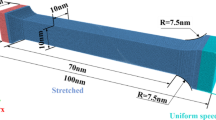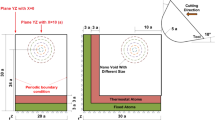Abstract
In order to investigate the microstructure evolution of single-crystal copper (SCC) subjected to nanocutting process under different crystal orientations, SCC with crystal oriented (0 0 1) [0 \(\overline{1}\) 0] is rotated around X and Y axes by 30°, 45°, and 60°, respectively. A nanocutting model is built based on large-scale atomic/molecular massively parallel simulator (LAMMPS), and molecular dynamics simulation (MDS) is used to test how the microstructure of SCC changes when subjected to nanocutting process under different crystal orientations, assuming EAM potential between Cu atoms and Morse potential between Cu atoms and the tool. The results show that the crystal orientation indicates a remarkable difference in chip morphology and cutting surface: under crystal orientation of rotating around X-axis, the chips are far wider and thicker than those under crystal orientation of rotating around Z-axis in all cases tested; under crystal orientation of rotating around X-axis, a sudden jump is detected on the cutting surface, whereas no such phenomenon is observed under crystal orientation of rotating around Z-axis. Crystal orientation also makes a marked difference to shear stress and dislocation form: under crystal orientation of rotating around X-axis, the shear stress is higher than that under crystal orientation of rotating around Z-axis; under crystal orientation of rotating around X-axis, the dislocation degree and maximum length of the dislocation line are obviously negatively correlated to the rotation angle. HCP atoms display roughly the same evolution as amorphous atoms; FCC atoms show a completely opposite profile to HCP atoms. The effect of crystal orientation on dislocation density also varies considerably across different types of dislocation.







Similar content being viewed by others
Data availability
On behalf of all authors, I confirm that all data are true and reliable.
Code availability
I speak for all authors: the software is reliable.
References
Zhang P, Wang Y, Wang Q (2018) On the precipitation behaviour of 7055 aluminium alloy during high-speed cutting. Mater Sci Technol 59:1–9
Hegab H, Umer U, Deiab I, Kishawy H (2018) Performance evaluation of ti–6al–4v machining using nano-cutting fluids under minimum quantity lubrication. Int J Adv Manuf Technol 95:229–4241
Teng X, Huo D, Chen W, Wong E, Zheng L, Shyha I (2018) Finite element modelling on cutting mechanism of nano mg/sic metal matrix composites considering cutting edge radius. J Manuf Process 32:116–126
Ji C, Sun S, Lin B, Sui T (2019) Evaluation of surface roughness produced by nanocutting copper structure using a least square mean method. Surf Rev Lett 27(01):195–206
Cao Z, Zong W, Zhang J, Xiao C, He C (2020) Desensitising effect of water film on initial decomposition of hmx crystal under nano-cutting conditions by reaxff md simulations. Mol Simul 125(11):1–11
Yang N, Xia Z, Wang X (2018) Phase change of carbon atoms in surface layer under nanocutting during diamond lapping process. J Tribol 140(3):032002
Jiang Z, Ogura I, Sawada H, Ashida K, Tanaka Y, Yabuno H (2018) Development of nano-scale mechanical cutting technique by using vibrational micro cantilever tool. In: Proceedings of JSPE Semestrial Meeting. The Japan Society for Precision Engineering
Singh RK, Sharma AK, Dixit AR, Tiwari AK, Pramanik A, Mandal A (2017) Performance evaluation of alumina-graphene hybrid nano-cutting fluid in hard turning. J Clean Prod 162(20):830–845
Zhu B, Zhao D, Zhao H, Guan J, Hou P, Wang S et al (2017) A study on the surface quality and brittle–ductile transition during the elliptical vibration-assisted nanocutting process on monocrystalline silicon via molecular dynamic simulations. RSC Adv 7(7):4179–4189
Xu F, Fang F, Zhu Y, Zhang X (2017) Study on crystallographic orientation effect on surface generation of aluminum in nano-cutting. Nanoscale Res Lett 12(1):289
Xu F, Wang J, Fang F, Zhang X (2017) A study on the tool edge geometry effect on nano-cutting. Int J Adv Manuf Technol 91:2787–2797
Jiang Y, Zhang X, Zhang C, Li Z, Sheng C (2017) Progress on fault mechanisms for gear transmissions in coal cutting machines: from macro to nano models. J Nanosci Nanotechnol 17(4):2274–2284
Gupta MK, Sood PK, Sharma VS (2016) Optimization of machining parameters and cutting fluids during nano-fluid based minimum quantity lubrication turning of titanium alloy by using evolutionary techniques. J Clean Prod 135(1):1276–1288
Dong W, Zhao J, Cao Y, Xue C, Yu B (2016) Wear behavior of an al2o3/tic/tin micro-nano-composite ceramic cutting tool in high-speed turning of ultra-high-strength steel 300 m. Int J Adv Manuf Technol 87:3301–3306
Uysal A (2016) Investigation of flank wear in mql milling of ferritic stainless steel by using nano graphene reinforced vegetable cutting fluid. Ind Lubr Tribol 68(4):446–451
Athens & Greece (2016) Cutting speed in nano-cutting as md modelling parameter. Int J Manuf 6(1):1–13
Padmini R, Krishna PV, Mohana Rao GK (2016) Experimental evaluation of nano-molybdenum disulphide and nano-boric acid suspensions in vegetable oils as prospective cutting fluids during turning of aisi 1040 steel. ARCHIVE Proc Inst Mech Eng Part J J Eng Tribol 230(5):493–505
Cui DD, Mylvaganam K, Zhang LC (2011) Nano-grooving on copper by nano-milling and nano-cutting. Adv Mater Res 325:576–581
Nakajima M, Hida H, Shen Y, Kojima M, Fukuda T (2012) Multi-slicing f C. elegans tissue using micro-nanocutting probe based on nanomanipulation. In: Nanotechnology. IEEE
Rao SN (2011) Experimental investigation of microbial contamination of nano cutting fluids with CNT inclusion. Glob J Res Eng 11(4):2249–4596
Zhang P, Zhao H, Zhang L, Shi C, Huang H (2014) A study on material removal caused by phase transformation of monocrystalline silicon during nanocutting process via molecular dynamics simulation. J Comput Theor Nanoence 11(1):291–296
Lin ZC, Hsu YC (2012) Analysis on simulation of quasi-steady molecular statics nanocutting model and calculation of temperature rise during orthogonal cutting of single-crystal copper. CMC-Comput Mater Continua 27(2):143–178
Zhang K, Gao H, Liu G (2012) Study on influence factors of silicon nitride nano-cutting process by molecular dynamics. Appl Math Inf Sci 6(3):807–812
Kukliński M, Bartkowska A, Przestacki D (2018) Investigation of laser heat treated monel 400. MATEC Web Conf 219(5):02005
Gao HY, Zhang K, Liu GZ, Sun H, Tang YL (2012) The simulation study of si3n4 ceramics nano-cutting process. Adv Mater Res 500:371–376
Niu Z, Jiao F, Cheng K (2018) An innovative investigation on chip formation mechanisms in micro-milling using natural diamond and tungsten carbide tools. J Manuf Process 31(1):382–394
Cheng K, Huo D (2013) Micro cutting: fundamentals and applications. John Wiley & Sons, Chichester
Jiaxuan C, Quanlong W, Yingchun L, Liquan W, Linqi Z, Yuanjiang S (2012) Nano-cutting molecular dynamics simulation of a copper single crystal. Proc Eng 29:3478–3482
Damian Przestacki & Tadeusz Chwalczuk. The analysis of surface topography during turning of Waspaloy with the application of response surface method..(eds.) Proceedings of 2017 2nd International Conference on Design, Mechanical and Material Engineering 2017, 88-93.
Zhang P, Liu Z, Liu J, Yu J, Mai Q, Yue X (2022) Effect of aging plus cryogenic treatment on the machinability of 7075 aluminum alloy. Vacuum 208:111692. https://doi.org/10.1016/j.vacuum.2022.111692
Zhang P, Liu ZH, Yue XJ, Wang PH, Zhai YC (2022) Water jet impact damage mechanism and dynamic penetration energy absorption of 2A12 aluminum alloy. Vacuum:206,111532. https://doi.org/10.1016/j.vacuum.2022.111532
Zhang P, Wang S, Lin Z, Yue X, Gao Y, Zhang S, Yang H (2023) Investigation on the mechanism of micro-milling CoCrFeNiAlX high entropy alloys with end milling cutters. Vacuum. https://doi.org/10.1016/j.vacuum.2023.111939
Gunnberg F, Escursell M, Jacobson M (2006) The influence of cutting parameters on residual stresses and surface topography during hard turning of 18MnCr5 case carburised steel. J Mater Process Technol 174(1-3):82–90
Zhang P, Lin Z, Liu Z, Liu J, Mai Q, Yue X (2023) Effect of cutting parameters on the microstructure evolution and damage mechanism of 7075-T6 aluminum alloy in micro cutting. Int J Damage Mech. https://doi.org/10.1177/10567895231171408
Wang JS, Zhang XD, Chen XW, Lai M, Xu FF (2014) Effect of crystal orientations on nanocutting based on quasicontinuum multiscale method. Int J Nanomanuf 10(4):371–389
Sharma A, Datta D, Balasubramaniam R (2018) An investigation of tool and hard particle interaction in nanoscale cutting of copper beryllium. Comput Mater Sci 145:208–223
Funding
The work was supported by the National Natural Science Foundation of China (51705270), the National Natural Science Foundation of China (No. 51575289), the Natural Science Foundation of Guangdong Province (No. 2023A1515030171), Science and Technology Project of Zhanjiang City, Guangdong Province (No. 2022A01004), the Natural Science Foundation of Shandong Province (No.ZR2016EEP03), the Applied Basic Research Program of Qingdao city (No. 19-6-2-69-cg), and Shandong Qingchuang Science and Technology Project (No. 2019KJB022).
Author information
Authors and Affiliations
Contributions
The design of the overall scheme was completed by Zhang Ping and Wang Youqiang. The design of the simulation scheme was completed by Yue Xiujie, Wang Shunxiang, and Lin Zhenyong. Data extraction was completed by Gao Yeran. Language modification was completed by Zhang Songting.
Corresponding author
Ethics declarations
Ethics approval
I speak for all authors: there are no ethical issues with manuscripts.
Consent to participate
All the authors of the manuscript agreed to participate.
Consent for publication
All the authors of the manuscript agreed to publish this paper in International Journal of Advanced Manufacturing Technology.
Conflict of interest
The authors declare no conflict of interest.
Additional information
Publisher’s Note
Springer Nature remains neutral with regard to jurisdictional claims in published maps and institutional affiliations.
Rights and permissions
Springer Nature or its licensor (e.g. a society or other partner) holds exclusive rights to this article under a publishing agreement with the author(s) or other rightsholder(s); author self-archiving of the accepted manuscript version of this article is solely governed by the terms of such publishing agreement and applicable law.
About this article
Cite this article
Ping, Z., Songting, Z., Zhenyong, L. et al. Investigation on the microstructure evolution and nanocutting mechanism of single-crystal copper under different crystal orientations. Int J Adv Manuf Technol 129, 815–823 (2023). https://doi.org/10.1007/s00170-023-12303-2
Received:
Accepted:
Published:
Issue Date:
DOI: https://doi.org/10.1007/s00170-023-12303-2




